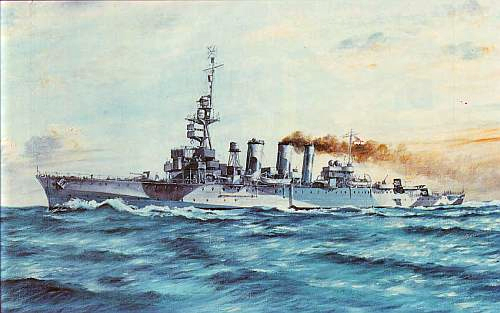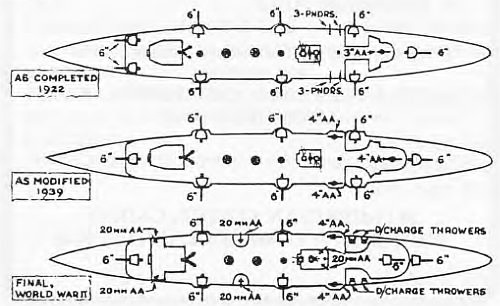- Author
- A.N. Other
- Subjects
- Ship design and development
- Tags
-
- RAN Ships
- HMAS Adelaide I
- Publication
- June 1994 edition of the Naval Historical Review (all rights reserved)
HMAS ADELAIDE – Light Cruiser

HMAS Adelaide (1922 to 1945) Painting by John Bastock
Displacement: 5,560 tons standard
Length: 460 ft (140.20 m) overall
Beam: 50 ft (15.24 m)
Draught: 18½ ft (5.63 m) max
Armament: As completed, nine 6-in (152-mm), one 3-in (76-mm) AA, one 12-pounder, four 3-pounders and ten smaller guns, and two submerged 21-in (533-mm) torpedo-tubes (broadside); 1939, eight 6-in (152-mm), three 4-in (102-mm), two 4-in (102-mm) AA, and several smaller AA guns, also depth-charge throwers
Protection: 3-in (7.6-cm) side armour-belt over ‘midships section
Machinery: Parsons turbines; twin screws
Horsepower: 25,000
Speed: 25½ knots
Fuel Capacity: Originally, 860 tons coal plus 550 tons oil; 1939, all oil, 1420 tons
Cost: Original, 1,272,000 Pounds; 1938-9 refit cost, 60,000 Pounds.
Complement: 470

Plan of Adelaide showing gun armament as built and as modified on two subsequent occasions
Designed as an improved version of the “Chatham” group of the British “Town” class light cruisers, with twin screws, part oil-fired boilers, nine 6-in (152-mm) guns of a later type with increased elevation, new type bridge, pole mainmast and other features. Adelaide was laid down at Cockatoo Island Dockyard, Sydney, in January 1915, launched on 27 July, 1918, completed on 31 July, 1922 and commissioned on 5 August, 1922. Originally with four funnels, during the refit of 1938-39 the fore-funnel was removed.
In point of basic design, Adelaide dated back to well before World War I, and in this regard she was the oldest British cruiser to serve in an active capacity throughout World War II.
In 1949 Adelaide was broken up at Port Kembla, NSW.




